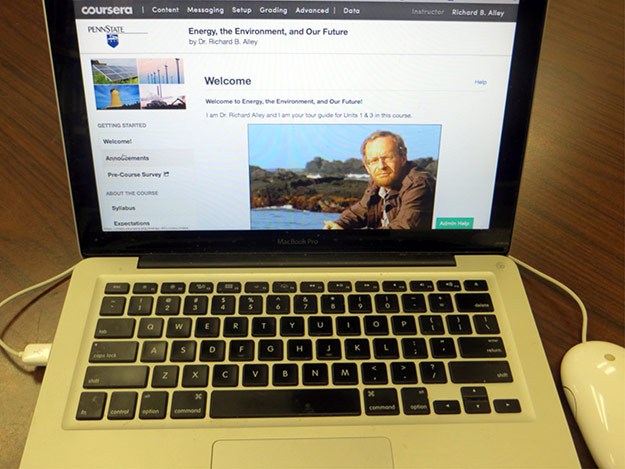Paying the Piper
![]() Earth: The Operators' Manual
Earth: The Operators' Manual
In case you want to remind yourself of where we might be going with renewables, here is a 7-minute roundup.
Video: Renewables Roundup (7:24)
(Richard Alley) Can low-carbon solutions really give us enough energy to power the planet and a growing population? Let's put some numbers on how much energy we can get from non-fossil fuel renewables... Today, all humans, everywhere on earth, use about 15.7 terawatts of energy. That's a big number. In watts, that's 157 followed by 11 zeroes, or one hundred fifty-seven billion of those 100 watt light bulbs we used as a reference. To show what's possible let's see if we can get to 15.7 terawatts, using only renewable energy. I'm here in the Algodones Dunes near Yuma, Arizona. The "Guinness Book of Records" says it's the sunniest place in the world. There's barely a cloud in the daytime sky for roughly 90% of the year. Zero point zero one percent... one one-hundredth of one percent. If we could collect that much of the sun's energy reaching the Earth, it would be more than all human of use today.
Today's technologies have made a start... This was the world's first commercial power station to use a tower to harvest concentrated solar energy. Near Seville, Spain, 624 mirrors stretch over an area of more than 135 acres... beaming back sunlight to a tower nearly 400 feet high. Intense heat produces steam that drives a turbine, which generates electricity. When completed, this one facility will be able to power 200,000 homes, enough to supply the entire nearby city of Seville. Remember our target of 15.7 terawatts? Well, the sun delivers 173,000 terawatts to the top of Earth's atmosphere... eleven thousand times current human use. No way we can capture all of that potential energy at Earth's surface, but the deserts of America's southwest, with today's technology, have enough suitable land to supply 80% of the entire planet's current use. Of course, there's one big problem with solar power... night.
But with more efficient transmission lines, and as part of a balanced renewable energy portfolio that includes storage, the sun's potential is vast. In tropical nations like Brazil, the sun heats water, makes clouds and unleashes rainfall that feeds some of the planet's largest rivers. Iguacu Falls is a tourist attraction, one of the most spectacular waterfalls on earth, where you can feel the immense power of falling water. The nearby Itaipu Dam, on the border of Brazil and Paraguay, produces the most hydroelectric power of any generating station in the world. This one dam supplies most of the electricity used in Sao Paulo, a city of more than 11 million. Sao Paulo is 600 miles away, but Brazil made the decision to build innovative high voltage direct current transmission lines to minimize energy loss. The Itaipu to Sao Paulo electrical grid has been in operation since 1984, and shows that renewable energy can go the distance. Dams can't be the answer for every nation... they flood landscapes, disrupt ecosystems, and displace people. But hydropower gives Brazil, a nation larger than the continental United States, 80% of its electricity. And world-wide, hydro-power could contribute 12% of human energy use... ready at a moment's notice, in case the sun goes behind a cloud.
Brazil is also using its unique natural environment in another way. Its tropical climate provides ideal conditions for sugarcane, one of the earth's most efficient plants in its ability to collect the energy of sunlight. Plantations like this one, harvest the cane for the production of sugar and the biofuel called ethanol. The U.S. is actually the number one producer of ethanol in the world, mostly using corn instead of cane. But ethanol made from sugarcane is several times more efficient at replacing fossil fuel than corn-based ethanol. Modern facilities like this one pipe back wet waste to fertilize the fields and burn the dry waste, called bagasse, to generate electricity to run the factory. For Brazil, at least, ethanol works. Today, almost all cars sold in Brazil can use flex fuels. Drivers choose gasoline blended with 25% ethanol, or pure ethanol, depending on price and how far they plan to drive. Local researchers say that if all the gasoline in the world suddenly disappeared, Brazil is the only nation that could go it alone and keep its cars running.
Using food for fuel raises big questions in a hungry world. As of now, sugarcane ethanol hasn't affected food prices much, but there are concerns with corn. So here in the U.S., government labs like NREL, the National Renewable Energy Lab, have launched programs to see if biofuels can be made from agricultural waste. It does work, and researchers are trying to bring the cost down. So with plants capturing roughly eleven times human energy use, they're a growing opportunity.
New Zealand takes advantage of another kind of energy. These are the geysers and hot springs at Rotorua on the North Island. Once they were used by the native Maori people for cooking and bathing. Now geothermal power plants harvest heat and turn it into as much as 10% of all New Zealand's electricity. Many power projects are partnerships with the Maori, benefiting local people and avoiding the "not in my backyard" problems that often complicate energy developments. Globally, geothermal energy offers three times our current use. But we can mine geothermal, extracting the energy faster than nature supplies it, cooling the rocks deep beneath us to make power for people. This energy exists even where you don't see geysers and mud pots, so it can be extracted without harming these natural wonders. A study by MIT showed that the accessible hot rocks beneath the United States contain enough energy to run the country for 130,000 years. And like hydroelectric, geothermal can provide peaking power, ready to go at a moment's notice if the sun doesn't shine and the wind doesn't blow.
Investments typically grow over time. But, if you don’t solve them, problems often grow too. And solving problems takes money, which could be invested now to solve problems later. Solve? Invest? Solve a little and invest the rest? Throw a party and worry about it later? What is a poor confused society to do? Call an economist!
Short version:
Using a calculation called discounting that is similar to interest-rate calculations, it is possible to estimate the present value or cost of future events. The discount rate, which is the real return you could get if you invested your money, is a function of the growth rate of the economy, as well as our preference for having things now rather than later (and thus us behaving as if our generation is more important than future generations). Actions to reduce CO2 emissions have costs now but benefits in the future. Thus, discounting is an important part of the economic models, called "integrated assessment models," used to compare possible paths to the future. The path that optimizes the tradeoff between these costs and benefits calls for beginning now to slow global warming, but in a measured rather than panicked way.
Friendlier but longer version:
We all face choices between today and tomorrow. Should I buy an apple now, or invest the money and have enough to buy two apples in a few years? Should I throw a party, or save the money to help support future generations of my family? Should I pay off the dangerous person who has suggested that if I don’t pay him he will punch my teeth out, or put the money into the hot new investment that will make me so wealthy that false teeth will seem cheap?


Economists have built a powerful intellectual framework for dealing with questions of this sort. The topic is usually discussed as discounting.
You can think of discounting as a tool to estimate the value or cost today of various future events. This allows you, or society, to compare the future results of possible decisions you could make today, and so choose the path that is least expensive or most beneficial overall.
Starting on the next page, we explain discounting with a little math. Note that we do not require that you master the math, or use it to calculate anything, but we owe it to you to show you how it goes. (And, we have found that knowing the math often helps, in many ways.) We then will apply the results to climate change.
Enrichment
Want to learn more?
Read the enrichment titled Discount Rate.
We can choose to spend money now to head off future climate change. Or, we can ignore climate change and just go about our business, spending money on things we consume now, but also spending some money on investments for the future. Then, our descendants can use their great wealth from those investments to deal with the problems caused by climate change. We will find that the economically optimal path takes a middle road, spending some money to reduce climate change but investing some money to make our descendants wealthy and letting them deal with the problems of climate change. This raises many other questions, some of which we will address. But, hard-nosed economics recommends some actions now to head off climate change.
